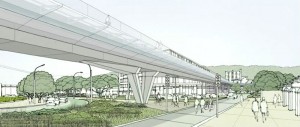We’re keen to evaluate the Basin Reserve, and have produced a Check List of items that we believe it needs to be evaluated against – as should any other possible Basin scheme as well.

We’ll be posting a critique of the official NZTA proposals next week – but first, without further ado, here are the issues that we think are the key points that any proposal really needs to address (also available at the end as a downloadable PDF):
1) Does there need to be a scheme?
– Why is the scheme being proposed and what is the evidence to support this need?
– Are there “non-physical” ways to address any needs (e.g. congestion charging?)
2) Does the scheme improve transportation in its broadest sense, and in a way which is appropriate for the future?
– Does the scheme improve existing access and safety into and across the Basin for cyclists (commuter and recreational), pedestrians (commuter and recreational) and public transport?
– Does the scheme elegantly integrate state highway and local traffic flows?
– Does the scheme provide dedicated busways designed in such a way that they can accommodate light rail in the future?
– Is the scheme sensible in the context of global warming, climate change, peak oil and peak car?
3) Does the scheme provide a better environment for the neighbourhood (e.g. schools in the area/Government House)?
– Is it safer for school students to walk, ride and take public transport to school?
– Does the scheme provide a better environment for children’s learning in terms of pollution and noise?
– Does the scheme improve access to the recreational spaces of the Basin reserve?
– Does it provide better quality of open spaces?
– Does the scheme engage Government House as an important part of Wellington as a capital city?
4) Does the scheme support the aims of the Urban Design Protocol and city council initiatives for adjacent areas?
– Is the scheme an example of excellent urban design?
– Is the scheme a good fit for this part of the city (e.g. its relationship to the Victorian Kent/Cambridge Tce?; the deformed city grid (deformed by its geography)).
– Does the scheme sit well in relation to the Adelaide Road plan, the Wellington Transport Strategy and the Ngauranga to Airport Growth/Transport Spine?
– Does the scheme support the Basin as a destination, rather than one of the world’s largest roundabouts cut off from its local community?
5) Does the proposed scheme respect existing cultural environment and add to it?
– Does the scheme respect areas of significance to local iwi?
– Does the scheme respect the siting, or better site, historic buildings (e.g. Ettrick Cottage, Government House, John Swan’s Compassion Creche)?
– Does the scheme respect areas of significance to local community groups (e.g. residents, sportspeople)?
– Does the proposal have well designed structures?
6) Is the cost warranted? and are the benefits (e.g. social, environmental, economic) of the scheme appropriately recognised?
– What is the cost/benefit analysis and does it understand costs and benefits beyond a narrow view of traffic flow (e.g. quality urban design, health, providing better recreational spaces, encouraging pedestrian/cycling, presenting cultural/environmental aspects of the area)? How does the cost benefit compare with other scenarios?
7) Is Wellington a better place because of this scheme?

Leave a Reply